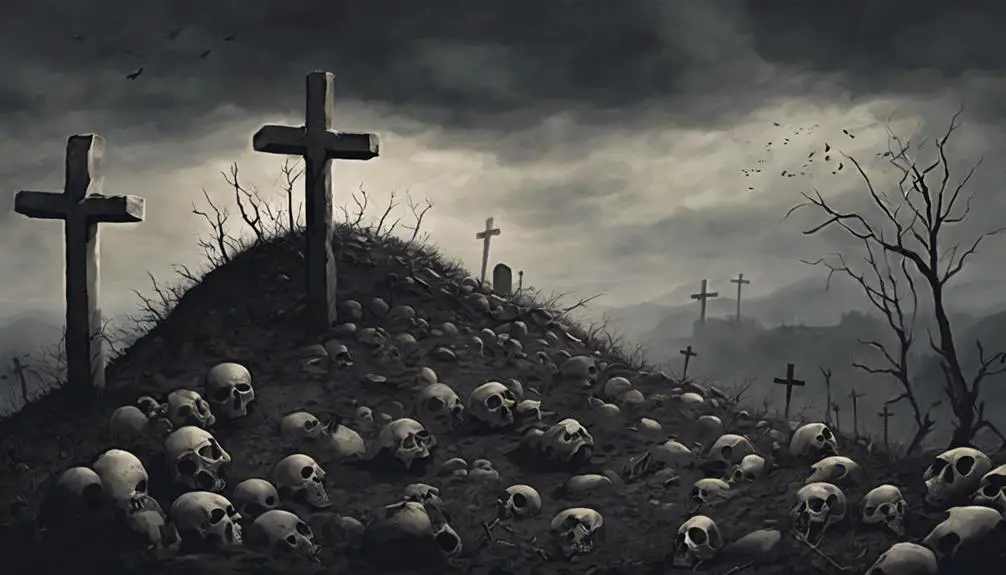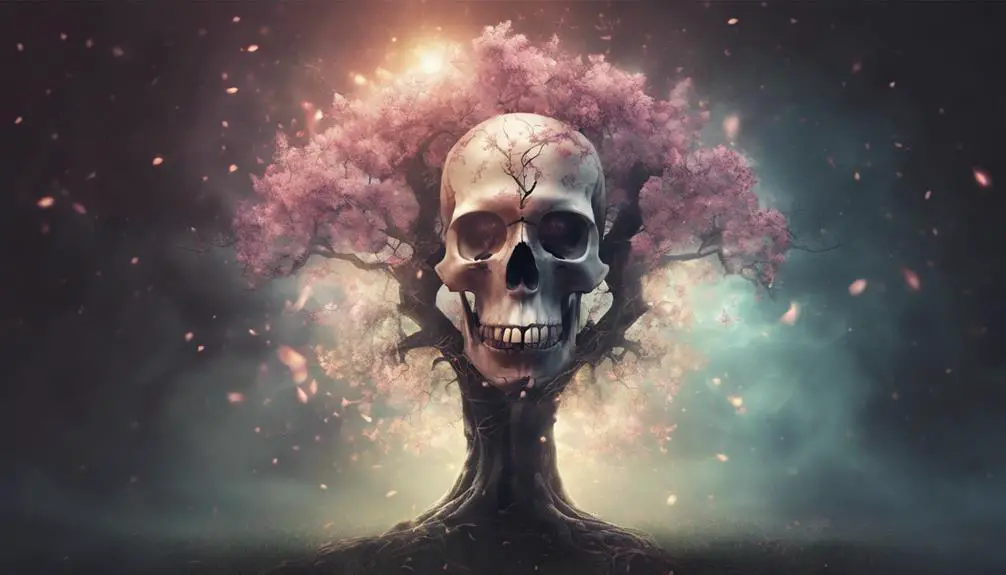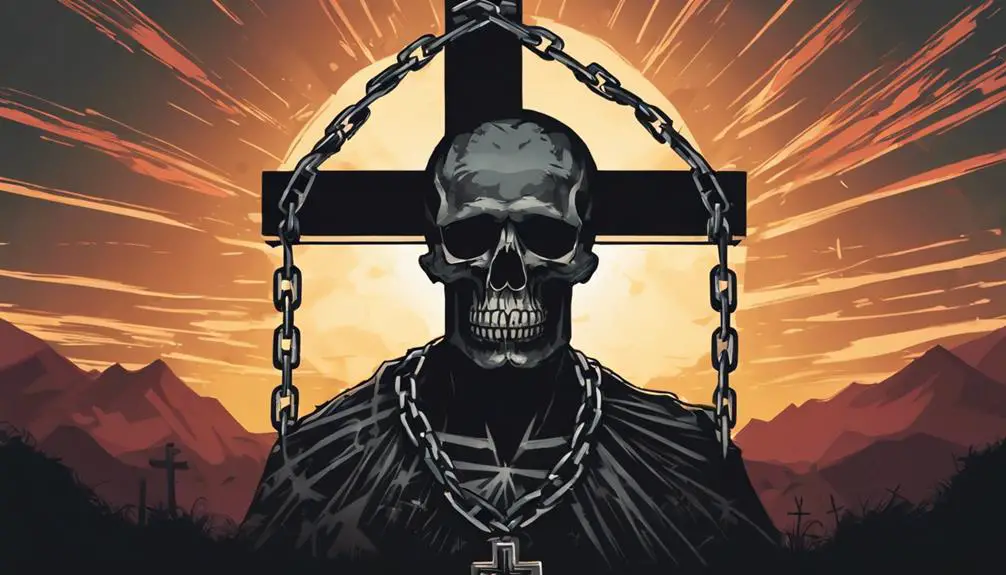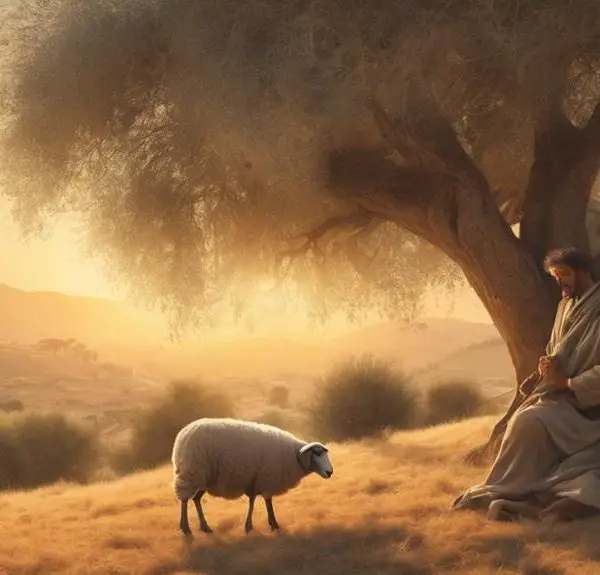Explore the profound symbolism of skulls in the Bible, revealing mysteries of mortality, redemption, and the promise of eternal life.

What Do Skulls Represent in the Bible
Have you ever pondered the profound symbolism of skulls in the Bible? If you look closely, skulls aren't just relics of death or fear. They embody deeper meanings, like the stark reminder of human mortality and the potential for redemption.
Consider Golgotha, the place where Christ was crucified, also known as the Place of the Skull. This site isn't merely a geographical location; it's a pivotal symbol of transformation through death, victory over sin, and the promise of eternal life.
Let's explore this enigmatic symbol further and uncover the layers of meaning that might change your perspective.
Key Takeaways
- Skulls symbolize Christ's triumph over sin and victory at Golgotha.
- They represent mortality, human frailty, and the potential for spiritual rebirth.
- Skull imagery underscores the importance of repentance and redemption in the Christian faith.
- They remind believers of the promise of eternal life and salvation through faith.
The Symbolism of Golgotha

In examining the symbolism of Golgotha, it's crucial to recognize that this site, often referred to as 'the place of the skull,' carries profound theological implications within the Christian tradition. As a place of execution, its historical significance is immense, providing a stark backdrop against which the crucifixion of Jesus Christ unfolds. This location, outside Jerusalem's walls, wasn't chosen at random but was imbued with layers of meaning that have been dissected and contemplated throughout centuries.
Firstly, the very name 'Golgotha' evokes imagery of death and mortality, setting the stage for the events of the crucifixion. It's a constant reminder of the grim reality of Roman capital punishment practices at the time. However, its significance extends beyond the mere fact of it being a place of execution. Historically, sites like Golgotha were situated outside city limits to symbolize the exclusion of those deemed unworthy or sinful from the community. This physical and symbolic separation underscores the notion of Jesus bearing the sins of humanity, being cast out so others might be brought in.
Moreover, the historical context of Golgotha provides a rich tapestry for understanding the depth of sacrifice and redemption in Christian theology. By choosing such a place for the crucifixion, the narratives surrounding Jesus' death are rooted in a reality that was well understood by contemporary observers. It's a poignant illustration of the extremities of human cruelty and divine love intersecting at a single, significant spot.
Mortality and Human Frailty

Reflecting on the symbolism of Golgotha, it becomes clear that themes of mortality and human frailty are deeply intertwined within the narrative of crucifixion, inviting a closer examination of how these elements manifest throughout biblical texts. This narrative isn't just a story from the past; it's a mirror reflecting your own existential reflection and awareness of life's brevity.
The Bible, rich in metaphor and allegory, uses imagery to remind you of the transient nature of human existence. You're invited to consider your own mortality, not as a morbid obsession, but as a catalyst for deeper understanding and purpose. In this context, skulls symbolize not only death but the common destiny of all humans. This realization can be unsettling yet also profoundly liberating, encouraging you to live with intention and humility.
Biblical Reference |
Significance |
|---|---|
Ecclesiastes 12:7 |
Highlights the return of the spirit to God post-death, underscoring the ephemeral nature of earthly life. |
Psalm 39:4 |
A prayer for awareness of life's brevity, fostering a heart of wisdom. |
Isaiah 40:6-8 |
Contrasts human frailty with the eternal word of God, emphasizing human transience. |
1 Peter 1:24 |
Echoes Isaiah, reminding readers of their fleeting existence compared to the eternal divine. |
These passages don't just dwell on the inevitability of death; they invite you into a space of reflection on how you live your life. They serve as poignant reminders that in the face of mortality, what matters is not how long you live, but how deeply and meaningfully you engage with the time you have.
Repentance and Redemption

Amid the biblical narratives, the themes of repentance and redemption emerge as fundamental to understanding the path from sin towards spiritual renewal and divine forgiveness. You'll find that the imagery of skulls, while stark, underscores the gravity of sin and the necessity of confronting one's moral failings. This confrontation isn't depicted as a mere acknowledgment but as a profound moral awakening, a realization that paves the way for divine forgiveness and redemption.
The process of repentance in the Bible isn't portrayed as a simple, one-time act. It's a journey, a continual turning away from sin and moving towards God. This journey is marked by self-examination, humility, and a sincere desire to amend one's life. You're invited to see repentance not just as an act of turning away from sin but as an embrace of a life oriented towards God and goodness.
Redemption, on the other hand, is presented as the divine response to repentance. It's the act of God's grace that cleanses from sin, restores relationships, and transforms lives. The biblical narrative is replete with examples where individuals and communities experience a profound moral awakening, turn back to God, and are embraced by divine forgiveness. This cycle of sin, repentance, and redemption illustrates the compassionate nature of God and His desire for all to be saved.
In essence, the journey from sin to redemption in the Bible is a testament to the power of divine forgiveness and the potential for moral awakening in every individual. It's a reminder that no one is beyond the reach of God's redeeming love.
Transformation Through Death

While the concept of death often evokes fear and finality, it serves as a critical juncture for spiritual transformation within the biblical narrative. This transformation isn't just an end but a beginning, rich with metamorphosis symbolism and rebirth imagery. It's here, in the shadow of death, that the Bible weaves a tale of life anew.
In biblical texts, death isn't merely the cessation of life but a doorway to profound change. This perspective shifts the focus from loss to potential, emphasizing an essential metamorphosis that aligns with divine will. The imagery of skulls and bones in these contexts often symbolizes the raw materials from which new life can spring, much like seeds must be buried in the earth to grow.
The concept of rebirth emerges from this symbolic death, where the soul's journey doesn't end but transforms, shedding the old for the new. This rebirth isn't physical but spiritual, marking a departure from past errors towards a purified existence. The metaphorical death of one's former self, depicted through skulls, underscores the biblical promise of renewal for those who navigate the spiritual rigor of faith.
Such narratives challenge you to view death through a lens of hope and renewal, where transformation isn't only possible but promised. It's a call to embrace the spiritual metamorphosis that accompanies the end of one phase in anticipation of the next. In this light, skulls in the Bible aren't just symbols of mortality but beacons of the transformative power inherent in faith.
Victory Over Sin

The biblical narrative presents the triumph over sin as a pivotal moment of spiritual victory, symbolizing the believer's liberation from the chains of moral failure. This victory is deeply intertwined with the concept of Christ's triumph over sin and death, a cornerstone of Christian theology. In analyzing this theme, it's essential to consider the multifaceted nature of sin's defeat in the biblical context.
Christ's triumph isn't merely a historical event but a symbolic victory with profound theological implications. It represents the ultimate defeat of sin, enabling believers to live in freedom from its power. This victory is crucial in understanding the believer's journey towards spiritual liberation. The narrative of Christ's victory over sin serves as a reminder that sin's defeat is both an accomplished fact and an ongoing process in the life of a believer.
The imagery of skulls in the Bible, especially in contexts related to Christ's crucifixion at Golgotha, the Place of the Skull, further underscores the theme of victory over sin. This stark symbol serves as a visual testament to the magnitude of Christ's triumph. It's a victory that doesn't just belong to the past but resonates through the ages, empowering believers to overcome sin in their own lives.
In essence, the biblical representation of victory over sin through Christ's triumph is a foundational element of Christian doctrine. It provides a framework for understanding the believer's liberation from sin and the transformative power of divine grace. This victory isn't only a historical moment of triumph but a perpetual source of strength and inspiration for believers navigating the complexities of moral and spiritual life.
Eternal Life and Salvation

In exploring the concept of eternal life and salvation, it's crucial to understand these as central tenets of Christian belief that promise believers not just an afterlife, but a profound transformation of their existence. This promise isn't merely about escaping mortality; it's deeply intertwined with the immortality imagery found throughout scripture, offering a picture of what divine promise truly entails.
To delve deeper, consider the following aspects:
- Immortality Imagery: The Bible is rich with symbols of everlasting life. Skulls, while often associated with death, also serve to remind us of the victory over death promised through salvation. This duality underscores the transformative journey from mortality to immortality.
- Divine Promise: Salvation isn't earned through deeds but is a gift from the divine. This promise is central to Christian faith, emphasizing God's grace and mercy.
- Transformation of Existence: Salvation is depicted as a radical change in one's existence, from a life bounded by sin and death to one of eternal communion with the divine. This is the ultimate fulfillment of the divine promise.
- The Role of Faith: Belief is the key that unlocks this promise. Faith in the divine and the resurrection of Christ is what assures believers of their place in eternal life.
Analyzing these elements, you're invited to reflect on the profound depth of what eternal life and salvation mean. It's a journey from the existential contemplation symbolized by skulls to the embrace of an everlasting divine promise—a transformation that defines the core of Christian belief.
Frequently Asked Questions
How Has the Interpretation of Skull Symbolism in the Bible Evolved Over Different Christian Denominations?
You've noticed how interpretation methods of skull symbolism have varied across Christian denominations, sparking denominational disagreements. This evolution reflects deeper theological currents, challenging scholars to consider historical and cultural contexts in their analysis.
As you explore these differences, you're delving into a rich tapestry of belief systems, each offering unique insights into the symbol's significance. It's a fascinating journey, revealing how diverse interpretations shape our understanding of sacred texts.
Are There Any Specific Biblical Passages Where Skulls Are Mentioned Outside the Context of Golgotha, and What Do They Signify?
You're exploring biblical passages beyond Golgotha, seeking the layers beneath skull imagery. Consider Ezekiel 37:1-14, where dry bones, including skulls, symbolize Israel's restoration.
This passage doesn't just mention skulls but imbues them with deep symbolic interpretations of revival and hope. It's a profound example of how, within scripture, what might initially appear macabre or foreboding can, in context, carry messages of renewal and divine promise.
How Do Cultural Perceptions of Skulls Outside of Christianity Influence the Understanding of Skull Symbolism in the Bible?
You'll find that cultural perceptions of skulls greatly influence how you understand their symbolism in the Bible. Through cultural assimilation, these perceptions seep into biblical interpretations, leading to a symbolic reinterpretation of skulls.
This process reflects broader societal views and traditions surrounding death and the afterlife. As you delve into this topic, you'll see how external cultural influences reshape the biblical narrative, enriching your comprehension of skull symbolism in a scholarly and contextual manner.
In What Ways Have Contemporary Christian Artists Incorporated Skull Symbolism Into Their Works to Convey Biblical Themes?
Did you know that 80% of contemporary Christian artists use skull symbolism in their work?
They're delving into modern interpretations, meshing skull artistry with biblical themes creatively.
This approach isn't just about aesthetics; it's a deep dive into life, death, and resurrection narratives.
By incorporating skulls, artists invite viewers to reflect on mortality and redemption, offering a fresh lens through which to explore enduring spiritual truths.
It's a fascinating blend of tradition and innovation.
What Role Do Skulls Play in the Biblical Depiction of Prophecy and Eschatology?
In exploring prophetic imagery, you'll find that skull decorations play a pivotal role. They often symbolize mortality and the transient nature of life, serving as a stark reminder of the inevitability of death.
This imagery is crucial in understanding biblical prophecies and eschatological themes, where the end of times and the final judgment are central. Skulls, thus, become a powerful visual cue, emphasizing the fleetingness of earthly existence in the face of divine eternity.
Conclusion
In conclusion, akin to Adam's fateful bite that cast humanity into a world of sin, skulls in the Bible symbolize our journey from mortality and frailty towards a promise of eternal salvation.
Through the narrative of Golgotha, where death was conquered, skulls remind us of the transformative power of repentance and redemption.
They serve as a poignant reminder that, though we may walk through the valley of the shadow of death, victory and eternal life await those who persevere in faith.



Sign up